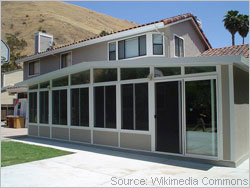
A sunroom is a wonderful addition to any home--it allows you to enjoy the great outdoors and beautiful sunshine while remaining indoors. There are various types of sunrooms and endless ways to customize the space depending on your needs and budget.
Read on for some information on building a sunroom to begin planning your project.
Types of Sunroom Additions
There are two main types of sunroom additions--a pre-fabricated "greenhouse" sunroom addition, made mostly of aluminum and glass and easy to assemble yourself; or a site-built, "stick" sunroom addition, which is costlier and requires the assistance of professionals.
- Pre-Fabricated Kits: These sunroom additions are pre-designed and made at another location and shipped to you unassembled. You can usually assemble them yourself, even using an existing deck or patio as a foundation. These additions can be practical if you simply want a no-frills place to grow plants indoors or dry off after a day in the pool. They have the appearance of a greenhouse--all windows.
- Site-Built: A site-built addition is constructed like any other addition to your home, with the aid of a contractor. The foundation is laid, walls are framed, and the roof is built. You may even opt to have the sunroom wired for electricity or plumbing installed.
Plan Your Project
Once you determine your needs and preferences for the project, it's time to make the necessary plans.
- Contact your local zoning board to find out the laws and codes you must adhere to when building the sunroom. You may also have to obtain permits for its construction.
- Set your budget for the project. Knowing in advance how much you can afford to spend on the sunroom and how you will finance it will keep you aware of your limitations when planning its design.
- Determine the desired location for your sunroom. The best spot will depend on the layout of your home and your needs. Ideally, you want to align the sunroom as close as possible to the "true south"--the position which receives the most direct sunlight throughout the day.
- Plan your sunroom's features and characteristics to discuss with your contractor. How large do you want the sunroom? Do you want to connect it to your home's heating and cooling systems? If not, how will you heat or cool it? Do you want it wired for electric? Plumbed? What types of windows and doors should it have? What type of flooring? These are all important questions to consider, as they will reflect the cost of your project and the comfort of your sunroom.
Flooring
When choosing the type of flooring for your sunroom, you should consider the room's temperature and outside elements. Since sunrooms are often used for lounging after swimming or working in the garden, they should be constructed with durable, weather-resistant materials.
- Ceramic tile: Moisture-resistant, and perfect for a sunroom without heat or air-conditioning. The floor will capture warmth from the sun to provide heat on chilly days.
- Stamped concrete or stone flooring: Low maintenance and durable, it will give your sunroom an outdoor patio look.
- Vinyl laminate: Made of plastic, vinyl flooring is inexpensive, easy to install, and 100 percent waterproof. Available in stick-on tiles, planks, or rolls, you can achieve almost any look with vinyl flooring--stone, wood, or "real" tiles.
Windows
The windows are an imperative part of the sunroom--the purpose of the room is to enjoy sunlight, so your windows will need to allow an adequate amount to filter it. They also play an important role in keeping your sunroom warm.
- If your sunroom is without heat, thermal glass windows will capture increased warmth from the sun.
- Vent skylights allow for even more sunlight exposure, and also help with ventilation in your sunroom. Conservatories are a popular style of sunroom, with all walls and the roof made completely out of glass.
- If your sunroom is not heated, a glass sliding door with an attached screen door connecting to your home is optimal to keep the cold air out in the winter while keeping the sunroom ventilated in the summer.